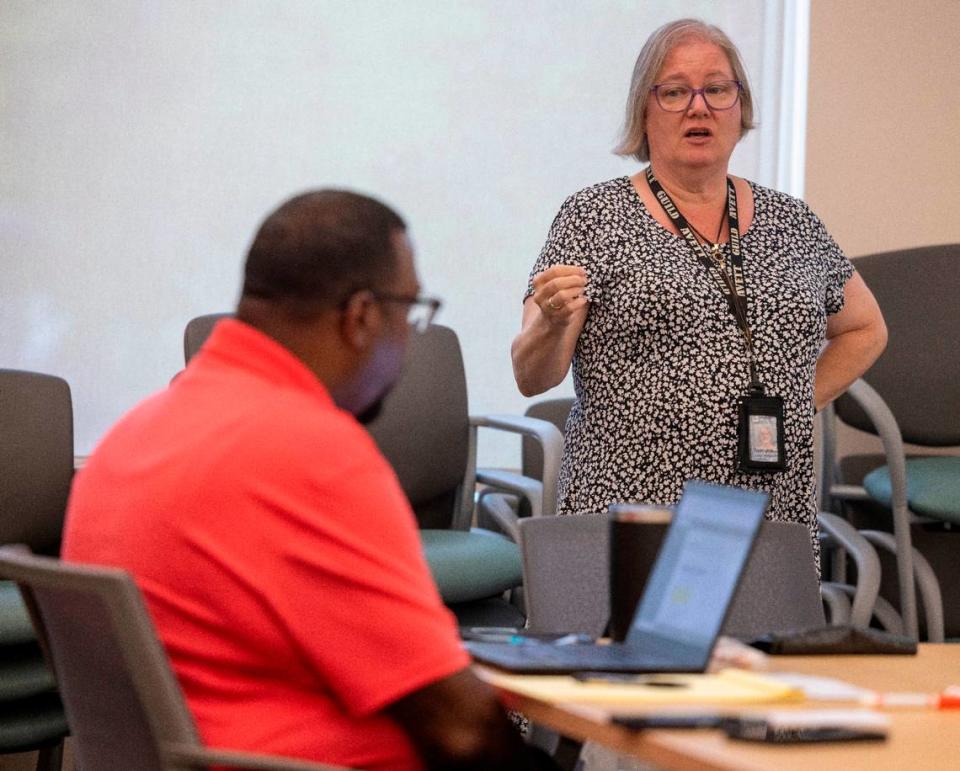More than 100,000 children in North Carolina face violence, substance abuse and neglect every day, often because their parents struggle to meet their basic needs.
Those drawing the attention of child protective services find a system also in crisis, with too few staff to provide urgently needed services and not enough foster homes to house them temporarily or permanently, government officials and advocates say.
The N.C. Department of Health and Human Services reports that so far this year, an average of 16 children per week are staying overnight in a Department of Social Services office because they have nowhere else to go.
Last year it averaged 32 children per week, according to NCDHHS spokeswoman Kandice Scarberry.
Others stay in emergency rooms and psychiatric centers because the state does not have enough foster homes. Placing children with special needs is even more difficult, advocates say.
The shortage of foster families has several causes, including too few child welfare staff to support the families who do this sometimes difficult work, The News & Observer reports.
The workforce is in crisis after several years of retirements, layoffs and vacancies at the county’s child welfare offices. Average employee turnover was more than 30% in 2023, according to an internal letter from Peter West, section chief of county operations for the N.C. Department of Social Services.
Some counties experienced employee turnover as high as 50% or more, compared with a national employee turnover rate of 14% to 22%, according to state and federal reports.
Child protection jobs can be challenging and emotionally draining, leading to burnout, secondary trauma and job dissatisfaction, according to state and federal reports. Staffers work with limited resources and face public perception that they are trying to take children from their families, West said.
“I still struggle with people knowing that I have been in this work in child welfare for over 25 years. They look at you like you’re trying to break up families,” West said. “It’s our job to do everything we can to keep children safe and families together, while helping them get to the other side of whatever they’re going through.”

Child welfare workers: understaffed and overwhelmed
A state study released earlier this year found that most child welfare workers feel overwhelmed, despite having workloads that largely meet state guidelines.
Intake staff, who review reports and determine next steps, must process up to 100 reports per month. Assessment and home care workers, who work directly with families, have a standard caseload of up to 10 families.
The national average in December 2022 was 45 intake reports per employee, and eight to twelve cases for each assessment and home care employee. But some counties, such as Orange County, reported more than 100 hiring reports per employee. Several counties also reported home health and assessment services caseloads two to four times higher than the state standard.
Foster care workers in some counties were handling several dozen cases at a time, despite a state standard of 15 cases, because a family can have multiple children with multiple outcomes.
The workforce crisis has worsened during the pandemic and has not recovered, West told The N&O in an interview. Child welfare workers are also dealing with more intensive needs related to substance abuse, domestic violence and mental health issues, he said.
A major challenge for many states, including North Carolina, is that the systems that record information about abuse and neglect cases are often inadequate, said Emily Putnam-Hornstein, a professor at the UNC-Chapel Hill School of Social Work and principal investigator for the national to live. Cut Short Project.
Employees must click through multiple screens to find the relevant history when investigating a case or make judgments about which boxes to check on a comprehensive checklist of potential risks a child faces, with limited time to do so, said she.
“In child welfare, we are asking employees to not only be responsible for those immediate safety decisions, but also hold them accountable for future risks of harm,” she said. “And what people aren’t very good at is gathering a lot of information and figuring out which of those children are most likely to be harmed in the future.”


A system that needs to be restructured
A further complication in North Carolina is structural, and an overhaul is underway, state officials say.
North Carolina uses a state-controlled, county-administered social services system — one of only nine such systems in the country, NCDHHS officials said.
While the system provides flexibility for the region’s child protection agencies to address local challenges and collaborate with regional partners, it also leads to inconsistent training and reporting, inadequate data, and children placed in unsafe situations.
A 2019 legislative report found that county DSS offices failed to provide services to families in more than a third of reported allegations across the state. But the percentage varied widely, from 12% of reports screened in some counties to as many as 60% in others.
Some infant deaths are unpreventable, Putnam-Hornstein acknowledged. But what’s really difficult is when an assessment of infant deaths uncovers human error or missing information that could have helped prevent a tragedy, she said.
“It’s heartbreaking because you realize that if we had collected all that in real time, we probably would have made a decision that would have protected that child, but we missed it,” she said.
Kella Hatcher, executive director of the NC Child Fatality Task Force, said the state’s child death prevention system is also “disjointed.”
“National experts have told us we have one of the most complicated systems in the country. Not the best or the worst – we do a lot of good work – but it is complicated,” she said.
Each county has two child mortality review teams: one for children involved in social services and one for other child deaths. Both report to the State Child Fatality Prevention Team, which also reviews deaths, and to the NC Child Fatality Task Force, which recommends policy changes.
Each group is led by a different state office.
The state is creating a State Office of Child Fatality Prevention this year and hiring regional DSS directors to help implement consistent policies and record keeping. By 2025, civilian child mortality review panels could be appointed, and local review teams could be replaced by separate teams covering one or more provinces.
These and other changes stem from Rylan’s Law, a set of child welfare and social services program reforms passed by the state Legislature in 2017. In 2019, the state DHHS conducted an extensive third-party investigation into the state’s workforce crisis and possible solutions.
In 2020, the state began reporting abuse and neglect cases that didn’t prompt an investigation or home services to the federal database. The move paints a more accurate picture of what’s happening and could connect more families with services, Scarberry said.
To report child abuse or neglect
North Carolina law requires all adults to report suspected cases of child abuse or neglect. Cases can be reported to 911, or your local social services or health department. The National Child Abuse Hotline is also available at 800-4-A-CHILD (800-422-4453).







